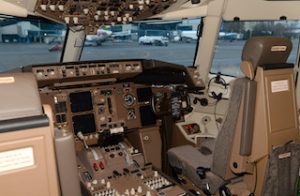How Does A Modern Jetpack Work?
 A jetpack is a device worn as a backpack that uses jet propulsion to lift the wearer into the air. Often depicted in science fiction, the jetpack has evolved into a real-world technology that promises to revolutionize personal flight. These devices combine advanced engineering, aerospace technology, and fuel systems to create a compact and functional tool for human flight. This article discusses how jetpacks work, their types, potential uses, and future prospects.
A jetpack is a device worn as a backpack that uses jet propulsion to lift the wearer into the air. Often depicted in science fiction, the jetpack has evolved into a real-world technology that promises to revolutionize personal flight. These devices combine advanced engineering, aerospace technology, and fuel systems to create a compact and functional tool for human flight. This article discusses how jetpacks work, their types, potential uses, and future prospects.
Jetpack
A jetpack is a wearable device designed to provide thrust, allowing the wearer to lift off the ground and fly. The primary mechanism involves the use of jet engines, which create propulsion by expelling high-pressure gas. By using controlled bursts of air or liquid fuel, the jetpack enables flight similar to that of a small aircraft but in a compact, portable form.
While most jetpacks are designed to be worn like a backpack, the technology behind them is complex, involving sophisticated fuel systems, jet nozzles, and control mechanisms. Modern jetpacks are powered by either gas turbines, electric motors, or a combination of both, making them viable for both short-range and longer flights.
How does a jetpack work?
Jetpacks work by generating thrust through jet propulsion. The propulsion system involves a high-pressure gas or liquid fuel, which is ignited and expelled at high speeds. As this gas exits the nozzles, it creates a reaction force that pushes the wearer upward. The basic principle behind this is Newton’s third law of motion: for every action, there is an equal and opposite reaction.
Jetpacks are equipped with a combination of thrusters, control mechanisms, and safety features. The thrusters are usually positioned at strategic points to provide balanced and controlled flight. By adjusting the amount of thrust generated, the pilot can control their altitude, speed, and direction. In some jetpacks, the wearer uses hand controls or body movements to manage flight dynamics.
Types of jetpacks
Jetpacks are available in several variations, depending on their propulsion system, fuel type, and intended use. The most common types of jetpacks are powered by either liquid fuel, gas turbines, or electric motors. Each has its advantages and limitations.
- Liquid fuel jetpacks: Liquid fuel jetpacks are powered by conventional jet fuel, such as aviation-grade kerosene or other high-energy liquids. These jetpacks typically have a fuel tank that stores the fuel and a combustion system that ignites it to create thrust. They offer high power output and longer flight times compared to electric-powered jetpacks. However, they are heavier and require more maintenance due to the complexity of their fuel systems.
- Gas turbine jetpacks: Gas turbine jetpacks are powered by small jet engines that function like those found in aircraft. These engines run on kerosene or a similar fuel and produce the thrust needed for takeoff and flight. Gas turbine-powered jetpacks offer impressive performance in terms of flight time and power. However, they are noisy, heavy, and can produce significant heat, which can be uncomfortable for the wearer.
- Electric jetpacks: Electric jetpacks use electric motors that are powered by batteries. They offer several advantages over liquid-fueled and gas turbine jetpacks, including quieter operation, fewer emissions, and lower maintenance requirements. However, they are limited by battery life, which can restrict flight time. As battery technology improves, electric jetpacks are expected to become more practical for commercial use.
- Hybrid jetpacks: Hybrid jetpacks combine electric motors with traditional jet engines or gas turbines. These hybrid models aim to balance the strengths of both systems. The electric motor can provide quiet, efficient power for low-speed operations, while the jet engines provide additional thrust for high-speed flight or vertical takeoff. Hybrid jetpacks are still in the experimental phase but show great potential for future development.
Components of a jetpack
A jetpack consists of several key components that work together to ensure safe and effective flight. These include the propulsion system, fuel tank, control system, and safety features.
- Propulsion system: The propulsion system is the heart of the jetpack. It includes the engines or motors that generate the thrust necessary for flight. In most cases, jetpacks use either gas turbines, electric motors, or a combination of both to create propulsion. The propulsion system is designed to provide controlled bursts of thrust to lift the wearer off the ground and maintain flight.
- Fuel tank: The fuel tank stores the energy source needed for the propulsion system. For liquid-fueled jetpacks, this is typically a tank that holds aviation fuel or another high-energy liquid. Electric jetpacks use rechargeable batteries to power the electric motors. The size and weight of the fuel tank affect the jetpack’s flight time and performance. In many cases, the fuel tank is designed to be as compact and lightweight as possible to maximize efficiency.
- Control system: The control system is responsible for regulating the jetpack’s flight dynamics. It allows the wearer to control altitude, direction, and speed. In simpler models, the controls may involve adjusting throttle levels or tilting the body. More advanced systems may feature joysticks, hand controls, or even motion sensors that detect the wearer’s movements and adjust the flight path accordingly.
- Safety features: Jetpacks are inherently risky due to the high speeds and potential hazards involved in flying. As such, safety features are a major consideration in their design. Many modern jetpacks are equipped with stabilizers and safety straps to prevent accidents. Some models feature automatic safety protocols that activate in the event of a malfunction, such as deploying a parachute or activating an emergency landing system.
Advantages of jetpacks
The jetpack offers several advantages that make it an attractive technology for personal flight. These include mobility, versatility, and the ability to access hard-to-reach areas.
- Mobility and convenience: A jetpack offers unparalleled mobility. Unlike helicopters or airplanes, which require runways or helipads for takeoff, a jetpack can lift off from almost any location. This flexibility makes it ideal for emergency situations, such as search and rescue operations, where quick access to difficult or remote areas is necessary.
- Versatility in use: Jetpacks have a wide range of potential applications. They can be used for leisure, military operations, emergency services, and industrial work. For example, jetpacks could be used by firefighters to reach burning buildings, by paramedics to access accident sites, or by law enforcement for pursuit and reconnaissance missions.
- Access to hard-to-reach locations: Jetpacks provide a unique ability to access locations that would otherwise be difficult or impossible to reach. For instance, they could be used to transport supplies to mountaintop research stations, assist in wilderness rescues, or carry equipment to remote construction sites. Their ability to reach challenging terrain makes them valuable for a variety of specialised tasks.
Limitations of jetpacks
While jetpacks offer exciting possibilities, they come with several limitations that must be addressed before they can become widespread.
- Short flight time: The main limitation of jetpacks is their relatively short flight time. This is particularly true for electric-powered models, which are limited by battery capacity. Liquid-fueled jetpacks can offer longer flight times, but they come with added weight and maintenance challenges. Improving battery technology and fuel efficiency will be key to expanding the viability of jetpacks for longer flights.
- Safety concerns: Jetpacks, by their very nature, pose safety risks. The user is exposed to high speeds, extreme altitudes, and potential equipment malfunctions. Although modern jetpacks come equipped with various safety features, accidents can still occur. As a result, extensive training is necessary to operate these devices safely. Additionally, regulations and safety standards for personal flight devices need to be established to ensure safe usage.
- High costs: Jetpacks remain a high-cost technology, with most models being prohibitively expensive for average consumers. The cost of materials, design, manufacturing, and maintenance all contribute to the price. As demand for personal flight devices grows, however, prices may decrease, making them more accessible to a wider range of individuals and organisations.
Future of jetpacks
The future of jetpacks holds great promise, with ongoing advancements in technology improving their performance and safety. As battery technology improves, electric-powered jetpacks may become more practical for commercial and personal use. Additionally, hybrid models that combine electric and gas-powered propulsion could offer longer flight times and greater efficiency.
The potential applications for jetpacks are vast. From military use to emergency response, jetpacks could revolutionize how we think about personal transportation. With advancements in materials, propulsion systems, and safety protocols, jetpacks may one day become as common as cars or motorcycles.
Great promise
The jetpack represents a remarkable advancement in personal transportation. While still in the early stages of development, it offers a glimpse into a future where individuals can fly freely through the air. With its mobility, versatility, and potential for access to hard-to-reach locations, the jetpack promises to transform industries ranging from emergency services to recreation. As technology continues to improve, jetpacks may one day become a mainstream mode of transportation, opening new possibilities for personal flight.










